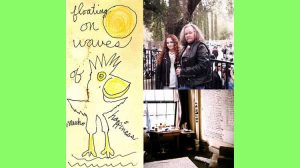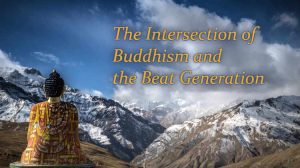
The relationship of Buddhism and the poetic process is a sublime yet unexplored topic among Western scholars. It’s about the silent space between the words, not just the word itself.
The poet John Keats writes:
At once it struck me what quality went to form a man of achievement, especially in literature, and which Shakespeare possessed so enormously – I mean Negative Capability, that is, when one is capable of being in uncertainties, mysteries, doubts, without any irritable reaching after fact and reason…” (Letter to his brother, 12/21/1817)
In a letter to Reynolds, 5/3/1818, Keats speaks of stepping into the “Thoughtless Chamber, in which we remain as long as we do not think.” This could mean nothing else but sunya, the Buddha-nature of thought-free emptiness. Keats describes his creativity in terms that Buddhists would recognize as anatta, no-self. In a letter to Richard Woodhouse (10/27/1818) he writes:
As to the Poetic Character itself… it is not itself – it has no self – it is everything and nothing… A Poet is the most unpoetical of any thing in existence, because he has no Identity – he is continually in and filling some other Body… I have no nature. When I am in a room with People, then not myself goes home to myself, but the identity of everyone in the room begins to press upon me, so that I am in a very little time annihilated.
Jack Kerouac echoes Keats in his Scripture of the Golden Eternity. “Strictly speaking, there is no me, because all is emptiness. I am empty, I am non-existent. All is bliss.”
What Keats calls “Negative Capability,” modern artists call “negative space.” Leonardo da Vinci wrote, “Of all the great things found among us, the Being of Nothingness is the greatest.” Negative Space is the lesson of Japanese minimalism that influenced Matisse and Van Gogh at the fountainhead of modern European art.
Miles Davis filled his solos with negative space, creating by subtracting. “Don’t play what’s there,” Miles said, “play what isn’t there.”
Silence between notes. White sky between plum blossoms. Void that births creation. Darkness before God says, “Let there be light.” The opening verses of the Bible describe the womb of creation in quite Buddhist terms, tohu wa bohu, in Hebrew meaning “formless and void.” So the Heart Sutra, core of Zen, declares: “Form is emptiness, emptiness is form.”
What the artist discovers in negative space, the mystic finds in pure awareness, free from the clutter of thought. Emptiness between stars, hollow in our throat and belly, vacuum in an atom, black hole at the center of the galaxy: these are all the same space. This space is awake. It is who we truly are. It is Awareness.
If you fall through the crack between quarks, into the vacuum of infinite possibility at the core of a proton, you will hear the music of the spheres. A pointless bindhu contains the information of the whole universe. The ancient Upanishads proclaim: “Ano raniyan, mahato mahiyan: One atom of the smallest is greater than the greatest.”
And so affirms Neruda, the modern poet: “I, infinitesimal being, drunk with the great starry void.”





Paul Maher Jr. says
This is especially applicable when applied toward Jack Kerouac, starting with his “snow dream” at six years old and referred to over and over again, references of which occur in The Haunted Life, elements of The Sea Is My Brother, The Town and the City and On the Road. I briefly mentioned negative capability in an essay published in Empty Mirror (“Jack Kerouac’s Creative Birth”): “It is applicable then to lend to Kerouac’s emerging poetic sensibilities Keats’ observation thusly described: “poetical character… has no self- it is everything and nothing- it has no character and enjoys light and shade; it lives in gusto, be it foul or fair, high or low, rich or poor, mean or elevated- it has as much delight in conceiving an Iago as an Imogen. What shocks the virtuous philosopher delights the camelion Poet… A Poet is the most unpoetical of anything in existence, because he has no identity, he is continually filling some other body.” This nice piece of writing puts it all in place. Thanks for writing!
Fred LaMotte says
Thanks for adding this. I would love to see your article. Can you share the link here?
Denise says
You can find “Jack Kerouac’s Creative Birth” here.
Sam Silva says
wonderful insight into the nature of art as nuance